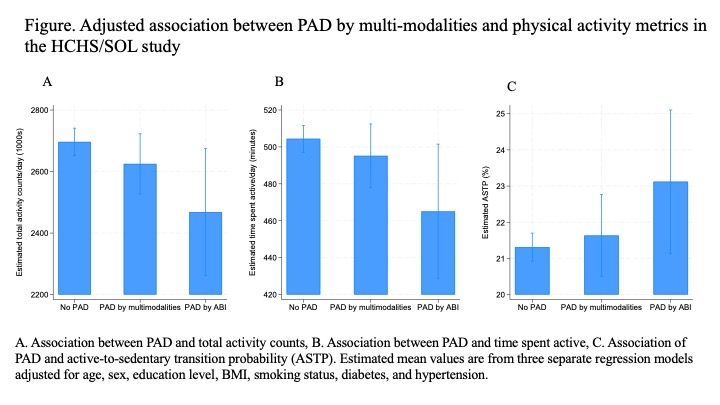Final ID: P2116
Peripheral Artery Disease Identified by Multi-Modalities and Accelerometry-Derived Physical Activity in the community: the Hispanic Community Health Study/Study of Latinos (HCHS/SOL)
Abstract Body: Introduction: Lower extremity peripheral artery disease (PAD) causes pain and discomfort with exertion, possibly leading to reduced physical activity (PA). Resting ankle-brachial index (ABI), the standard method for diagnosing PAD, has low sensitivity in the general population.
Aim: To examine the association between PAD, identified using two definitions (ABI only and several different modalities), and accelerometry-derived PA in HCHS/SOL.
Methods: Using interim data from 2,901 participants (mean age = 63 years; 67% female) from four U.S. sites, PAD was defined as (a) a resting ABI ≤0.90 or (b) if there was a significant drop in post-exercise ABI or at least 2 of the following conditions: 1) toe-brachial index ≤0.6, 2) abnormal Doppler waveforms, or 3) abnormal pulse-wave recordings. PA was measured 24 hours a day over 7 days using wrist-worn accelerometers and summarized as total activity counts/day (TAC), active time (min/day), and activity fragmentation (active-to-sedentary transition probability [ASTP], [higher=more fragmented]). We fitted linear regression models, adjusted for age, sex, smoking, adiposity, diabetes, and hypertension, and accounted for sampling weights.
Results: PAD was identified in 104 participants (3.6%) by low resting ABI and 386 (13.3%) via the other modalities. When compared to those without PAD, those with an ABI ≤0.90 had lower and more fragmented daily PA (beta for TAC -227.9 [95% CI: -437.4, -18.4], active time -39.3 min [-76.5, -2.2], ASTP 1.8% [-0.2, 3.9]). Those with PAD identified by the other tests (vs. no PAD) also showed lower activity and more fragmented PA, but these associations were not statistically significant (Figure).
Conclusion: PAD identified by a resting ABI ≤0.90 was significantly associated with lower and more fragmented PA, while PAD identified through other methods showed weaker associations with PA, suggesting that further research is needed to clarify how PAD with resting ABI >0.90 may affect PA.
Aim: To examine the association between PAD, identified using two definitions (ABI only and several different modalities), and accelerometry-derived PA in HCHS/SOL.
Methods: Using interim data from 2,901 participants (mean age = 63 years; 67% female) from four U.S. sites, PAD was defined as (a) a resting ABI ≤0.90 or (b) if there was a significant drop in post-exercise ABI or at least 2 of the following conditions: 1) toe-brachial index ≤0.6, 2) abnormal Doppler waveforms, or 3) abnormal pulse-wave recordings. PA was measured 24 hours a day over 7 days using wrist-worn accelerometers and summarized as total activity counts/day (TAC), active time (min/day), and activity fragmentation (active-to-sedentary transition probability [ASTP], [higher=more fragmented]). We fitted linear regression models, adjusted for age, sex, smoking, adiposity, diabetes, and hypertension, and accounted for sampling weights.
Results: PAD was identified in 104 participants (3.6%) by low resting ABI and 386 (13.3%) via the other modalities. When compared to those without PAD, those with an ABI ≤0.90 had lower and more fragmented daily PA (beta for TAC -227.9 [95% CI: -437.4, -18.4], active time -39.3 min [-76.5, -2.2], ASTP 1.8% [-0.2, 3.9]). Those with PAD identified by the other tests (vs. no PAD) also showed lower activity and more fragmented PA, but these associations were not statistically significant (Figure).
Conclusion: PAD identified by a resting ABI ≤0.90 was significantly associated with lower and more fragmented PA, while PAD identified through other methods showed weaker associations with PA, suggesting that further research is needed to clarify how PAD with resting ABI >0.90 may affect PA.
More abstracts on this topic:
Achieving Guidelines within a 24-Hour Movement Paradigm and Risk of Cardiovascular Disease and All-Cause Mortality in United States Adults
Boudreaux Benjamin, Xu Chang, Dooley Erin, Hornikel Bjoern, Munson Alexandra, Shechter Ari, Palta Priya, Gabriel Kelley, Diaz Keith
Acculturation Class Influences Physical Activity Among African Immigrants Living with Diabetes and/or Hypertension: A Qualitative AnalysisOsokpo Onome, Bracy Danny, Adeniji Dolapo, Bankole Ayomide Okanlawon, Lewis Lisa, Riegel Barbara

